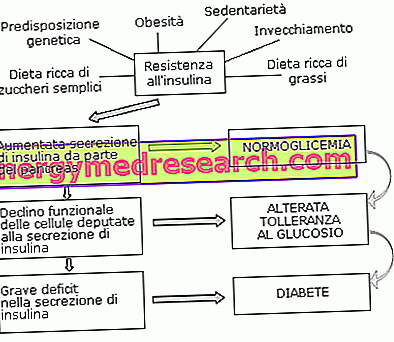It is the conclusion that could be drawn by reading an experimental work on metabolic interactions concerning pasta and the human organism.
Obviously, this is an extremely provocative statement which, on the other hand, undermines the most recent theories on the overweight of the Italian population.
Below we will try to better understand what are the most recent discoveries concerning the interaction between glycemic load and level of physical activity. The results mainly concern: cellular oxidation of carbohydrates (taken with pasta and endogenous), glycogen turnover, liposynthesis and lipolysis.
The study is not of the most recent (2001) but, it is not known why, it remained rather unnoticed. Obviously, like all the experimental ones, not even this should be considered an absolute "revelation", but a small cog that could contribute to the understanding of the enormous machine-man.
Among those who follow and promote low-carb diets, what will be mentioned below may seem like a paradox, but it is not. The results and conclusions of this work certainly do not indicate that you lose weight more (or faster) by eating large portions of pasta, on the other hand rather effectively denies the idea that this food (and therefore the starch it contains) represents a predominant cause of increased fat.
The title is: " Metabolic response to small and large 13C-labeled pasta meals following rest or exercise in man ", or " Metabolic response of small and large portions of pasta, with carbon 13 reactive, followed by rest or exercise in humans ".
The metabolic response of the organism to a portion of 150g or 400g of pasta labeled with reactive carbon 13 (13C) was observed for 8 hours; the intake was followed by complete rest or exercise at low or moderate intensity (6 groups in total).
In resting subjects after eating, the 400g portion of pasta totally suppressed the metabolic oxidation of lipids and only a small amount of glucose was converted into fatty acids (4.6g).
In contrast, consumption of the 150g portion of pasta allowed the metabolism to continue lipid oxidation (14.1g).
For all subjects who performed physical exercise (low and moderate intensity), fat oxidation remained high; both in those who consumed the 150g portion (21.8g and 34.1g), and in those who consumed the 400g portion (14.1g and 32.3g).
The cellular use of glucose from starch in the portions of pasta (labeled with 13C) was significantly higher in subjects at rest, both after the 150g portion (67.6g, against 60.4g and 51.3g in the subjects that carried out low and moderate workloads), both after the 400g one (152.2g, against 123.0g and 127.2g in the subjects who carried out low and moderate workloads).
The cellular use of glucose from starch in portions of pasta (labeled with 13C) was similar in the three groups (at rest, with light and moderate exercise) who consumed the 150g portion (42.3g-58, 0g).
In contrast, the cellular use of glucose from starch in portions of pasta (labeled with 13C) was significantly lower in the group that consumed the 400g portion and exercised light physical activity (24.2g against 72.2g a rest).
The cellular use of glucose from starch in portions of pasta (labeled with 13C) appeared to be totally suppressed in subjects who carried out moderate physical activity.
Predictably, a greater glycogen deposit was observed in subjects who consumed a 400g portion of pasta and then underwent light and moderate physical activity (182.8g-205.1g).
In contrast, in subjects who consumed a portion of 400g paste and remained at rest, the glycogen deposition was limited (92.4g).
The analysis of the total lipid oxidation concerns the period between 08:00 and 20:00, and was quite similar in the subjects who carried out light and moderate physical activity.
To conclude, the results suggest that:
The de novo lipogenesis, which plays a minor role in the disposal of a large load of pasta carbohydrates, is totally suppressed by physical exercise.
The reduction of glycogen turnover, as well as the preferential conversion of glucose into glycogen, are responsible for the increase in metabolic deposition of glycogen following exercise.
At the same energy expenditure, low intensity exercise for a longer period of time does NOT promote fat oxidation if post-exercise time is also considered.
From the above it is easily deducible that, under reasonable conditions, the starch of the pasta (complex carbohydrates) and the consequent glycemic load are NOT responsible for the adipose deposit; in particular, a 150g portion seems completely harmless as it does not hinder the oxidation of fatty acids and does not promote lipogenesis. Furthermore, even when consuming large quantities of pasta, for example 400g, lipogenesis can easily be prevented by carrying out physical activity of slight or moderate intensity. It is not pasta that makes you fat but sedentariness; certainly, it is unthinkable to be able to lose weight (especially in conditions of insulin resistance) by eating 400g of pasta per potion.
Instead it is reasonable to think that, within a meal, the carbohydrates of the dough act as insulin boost. The hormone, which has an anabolic and anticatabolic effect, would not in any case be able to predispose to a large extent the conversion of glucose into fatty acids and store them in adipose tissue. However, a meal is never composed exclusively of boiled pasta; they are part of the same recipe, or other courses, also: sauces, condiment fats, cheese or other products containing lipids and proteins. While protein amino acids play a marginal role in the adipose deposit (in reasonable and proportionate quantities to the meal), food and dressing fats, once digested and absorbed, are affected by the boost-insulin action of the carbohydrates ending up directly in the fatty tissue .



